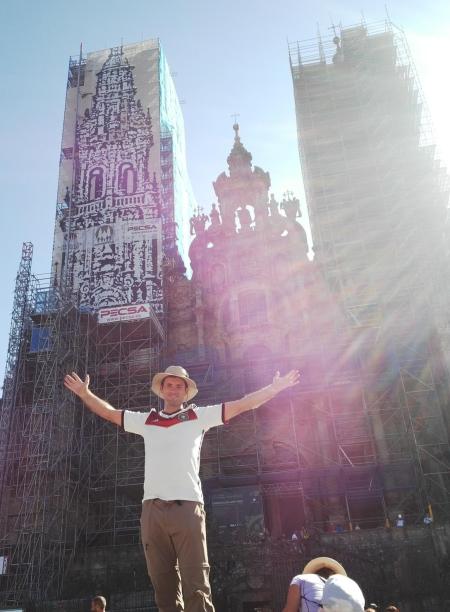I flew to Bilbao on the 11th of August and took a train to Burgos. From there I walked 500km over 21 days to arrive in Santiago. Although technically a Catholic pilgrimage, I approached it secularly as a walking holiday, a different environment while in-between jobs and some time for myself. Everyone walks their own Camino.
First Insight: There is suffering
On arrival in Burgos, I needed to first get a ‘Credential’, which allows sleeping in the albergues for Peregrinos along the route, and records qualification to recieve a Compostela at the end of the journey. A credential may be obtained from the municipal albergue in Burgos so that was my first stop. It was almost 8pm when I arrived and the Hospitalero had been telling people since 4pm that the albergue was full. However, he kept a spare bed for such late arrivals and luckily he gave it to me. It made for a good start.

Many sunflowers on the Meseta
Stated in a deliberately impersonal way, the nature of suffering on the Camino was immediately apparent when I arrived in Burgos. For most people (with sufficient time), The Camino starts in St. Jean Pied de Port in France from where pilgrims walk over the Pyrenees, and through Pamplona before arriving in Burgos two weeks later. Colloqially, this first of three stages of the walk is known as the ‘Camino of Suffering’, where the pilgrim starts the challenge and experience. I spent the first evening with a few people who had developed the blisters and the tendonitis, people who were bidding farewell to the journey already (some people do it over multiple years), and people who were bidding farewell to companions.
In the morning I got up at 6am and started walking in the dark out of Burgos, following the centuries-old route along the second stage – the ‘Camino of Death’, so called because of the barren, flat landscape surroundings until reaching Astorga.
Initially I walked with one Italian guy and we soon caught up with two more Italians. Most of the time walking the Camino is spent walking alone though, so that little group quickly dissolved as people broke away or fell behind (ahem!). A social shock I experienced is that when someone in a group stops or slows (even one more-familiar than a few hours/days), the others simply continue on – they’re sure to be re-united at a break-point or end point later along the way. It’s something to get used to.

My shadow’s the only one that walks beside me… I have tonnes of photos like this. Depending on whether I like you, I might sit you down to show you all of them!
Second Insight: Suffering should be understood
One of the things I learned on the Camino is that ‘normal’ is partly an environmental concept. It became ‘normal’ for me to get up at 6am, walk 20-30km per day, eat with some strangers and some familiar faces and go to sleep at 10pm. It did take about a week for that to become ‘normal’ (and even enjoyable!), but it is certainly not similar to my Berlin experience.

Dawn
I had blisters since the first day of walking, but by the time I reached Bercianos I was no longer able to stand, let alone walk. I had a day off followed by a 7km walk to the next town where I happened to meet a foot doctor from Berlin who gave me all the help I needed, including her sandals. My footwear was the problem causing my blisters (I was walking in running shoes), so I bought myself a good, expensive pair of sandals when I got to Leon, gave the good doctor hers back and had no new problems caused by footwear for the next two weeks. What are the odds of a foot doctor having the same size feet as me?

Chica the dog
Most of the people I encountered on the Camino were Italians, Spanish a close second, and plenty of Germans. I fell into a good rhythm with a group of Germans for the second two weeks which was nice. We spoke German as our common language.

Third Insight: Suffering (of my Camino) has been understood
Astorga is a beautiful town and it marks the transition of the peregrino from the ‘Camino of Death’ into the ‘Camino of Life’. The route through Galicia is much more steep than the previous stages and full of the sights, sounds and smells of dairy farms. Most of the milk produced in Spain is produced here. The sunflowers filling the landscape and the trail are long since gone.
Although the blisters did not return, the steep climbs and descents brought with them some tendonitis for the final two days of walking. Not much to complain about, timing wise.
It’s sad that the experience of walking the Camino can’t be captured by any camera or prose, but must be experienced to be understood. That’s just part of the nature of suffering :).

Like many, I continued on to Finisterre for a few days of sleeping on the beach and unlike most I spent the weekend after in Barcelona, for a very different experience of parks and beaches.





